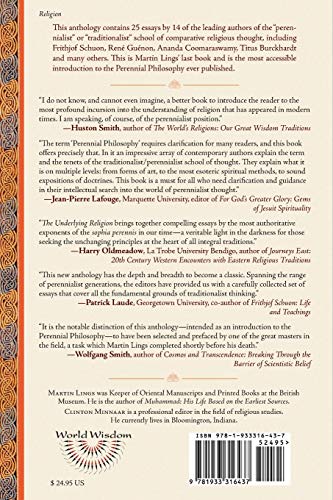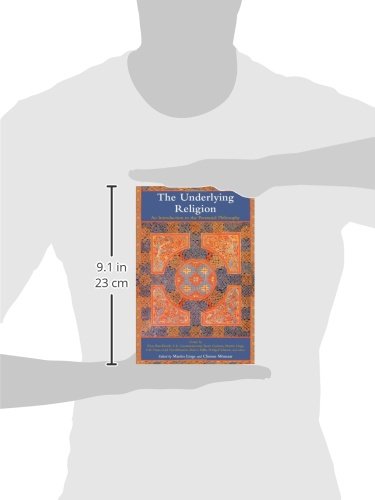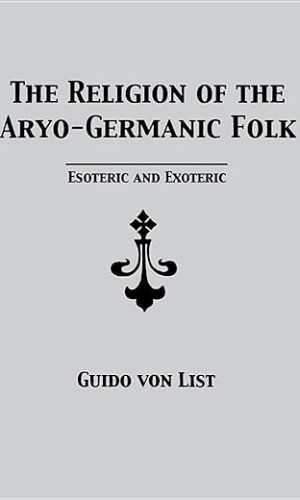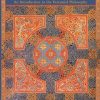The Underlying Religion: An Introduction to the Perennial Philosphy (Perennial Philosophy)
£15.20
THE UNDERLYING RELIGION is an anthology of 25 essays by 14 of the leading exponents of the “Perennialist” or “Traditionalist” school of comparative religious thought, associated with René Guénon, Ananda Coomaraswamy and Frithjof Schuon. This school is well known for its espousal of the “transcendent unity of religions” the idea that religions are different paths leading to the same summit. Focusing its selection on the most accessible of the Perennialist writings and structured in such a way as to allow for the easiest possible comprehension, Martin Lings was Keeper of Oriental Manuscripts and Printed Books at the British Museum. He is the author of the widely known and admired book Muhammad: His Life Based on the Earliest Sources and was himself one of the most prominent and active Perennialist authors of the 20th century. Dr. Lings died in May, 2005. Clinton Minnaar is a professional editor in the field of religious studies. Originally from South Africa, he currently lives with his wife in Buenos Aires, Argentina.
Read more
Additional information
| Publisher | World Wisdom (18 July 2007) |
|---|---|
| Language | English |
| Paperback | 368 pages |
| ISBN-10 | 9781933316437 |
| ISBN-13 | 978-1933316437 |
| Dimensions | 15.52 x 2.67 x 23.24 cm |







by Essam Qais
The Underlying Religion attempts to summarize the main tenets of the Perennial Philosophy. This philosophy appeared in an age where religion is treated as the residue of primitivism; and people should or must replace it with modernism and science.In fact, in many parts of the world, many people follow this prescription directly or indirectly. The book is divided into seven parts and they are as follows:
Tradition and Modernity
Traditional Cosmology and Modern Science
Metaphysics
Symbolism
The Perennial Philosophy
Beauty
Virtue and Prayer
The book presents religion in a different way which is might seem strange to some readers. The understanding of perennial philosophers of religion is deep, esoteric and sometimes shocking. They dig deeper into the essence of almost all great religions in order to show us that all religions are from the same source, they are different only exoterically .The book is a heavy read, and I personally skipped two parts, namely Evolution and I don’t understand evolution and honestly I’m not interested in the evolution theory. The Symplegades is very dense and contains many of Hindu terms that I don’t understand. The book has advantages and disadvantages. The advantages of this book lie in its ability to tell implicitly the reader, mostly Western reader, that religion is not merely the result of fear or the stupidity of our ancestors, on the contrary; religion is a message from heaven to save humanity. The disadvantage of this lies in difficulty of its language. Its language replete with classical words and sometimes you have to read one passage several times in order to understand it. Furthermore, there is no glossary of terms, which is very significant in this book, instead the editors refer the reader to a web site. They could have included a glossary of terms at the end of every chapter, since this book contains many terms from several languages and religion. Finally, I recommend this book for those who want to deepen his/er knowledge of the esoteric aspect of religions, and I also recommend this book for those who think that religion is only the result of fear and stupidity.
by HKS
The underlying religion is billed as a comprehensive introduction to the Traditional or Perennial philosophy. Edited by Martin Lings, the book is a collection of essays penned by some of the most influential exponents of Perennialist philosophy, including Marting Lings himself, as well as the likes of Fruthof Schunn and Rene Geunon.
The book is divided into 7 chapters (below), with each chapter consisting of one or more essays.
I. Tradition and Modernity
II. Traditional Cosmology and Modern Science
III. Metaphysics
IV. Symbolism
V. The Perennial Philosophy
VI. Beauty
VII. Virtue and Prayer
I very much enjoyed the first part of this book which deals with secularism, its flaws, and the superior status of religious tradition. The essays entitled “The deuhamnisation of modern man”, “Evolutionism” and “looking back on progress” in particular, are highly thought-provoking pieces which sum up much of what is wrong with the modern world. As with all books of this nature, one is often left confused by some of the deeper concepts presented – this was the case for me, with the chapter on symbolism. I vaguely understood the concepts introduced, but had trouble relating to (or recognising the importance of) symbolism in Perennial thought. The chapter on beauty, like the one on symbolism, failed too, to strike a chord with me. The book ended on a solid note, with essays by Shcuon outlining the importance of prayer in its exoteric and esoteric forms.
My one gripe with this collection is the manner of writing employed. The problem, it seems, with intellectuals of this ilk is the needless complication of ideas. The language, at times, is verbose to the point where one reads a paragraph half a dozen times and still has difficulty to grasp its message. I do understand that these are a collection of essays written initially, for a different (non introductory) audience but I do, nonetheless, feel that authors should attempt to make their (in this case, wonderful) ideas as accessible as possible. The success of recent polemicists (in areas such as politics, secularism etc) is their ability to condense and simplify messages for mass consumption, without said message losing its any of its core meaning.
However, this book is a collection of stand-alone essays united by a single theme. And if you find yourself flummoxed by one particular essay’s meandering sentences and overblown metaphor, you can always turn to the next essay – as I did on at least one occasion.
In summary; these essays are a thoroughly worthwhile read for anyone interested in perennialism as a philosophy, as well as those who find themselves disgruntled with modernism and its excesses.
Highly recommended.